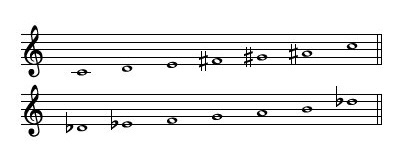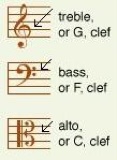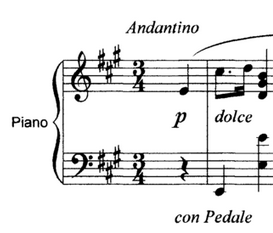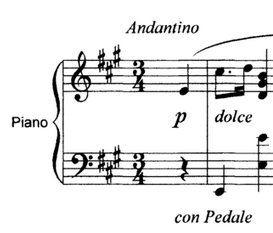Standard Notation
The standard notation is the notation that everyone has seen at least once in their lives. It is the most common form of notation that we encounter very early on in our lives as it has become a symbol of music thanks to the great Classical composers of our time. We will not cover any advanced details of standard notation since we don’t need full knowledge at this time. We simply need to understand the most basic concepts so that you can recognize the differences in notation formats as well as the upcoming lessons. Please understand that while standard notation is considered ‘standard’ it is by no means ‘simple’ but can actually be a huge topic. In fact, standard notation is the ultimate form of notation as there is literally a symbol, instruction, or notation for everything that any instrument can do. We simply don’t need all that information at this time.
Standard Notation therefore consists of 5 horizontal lines. Each line and space represent a note.

When looking at standard notation, from left to right, the first symbol you will see is the ‘clef’. Coincidentally, the word ‘clef’ is the French translation to the word ‘key’ however the word ‘clef’ in this case specifically refers to the symbols you first see on the staff (single term for staves) and although it does not refer to the ‘key’ of a song as we described in the lesson about Keys, it does provide an idea of the note ranges of a song. There are 3 different types of clefs and the only way you can really understand how they look is to refer to the following image as I don’t know how to actually describe the shapes of these symbols.

The first clef is the Treble or G clef. Just as we saw in the lessons about tone where ‘treble’ is used to describe higher frequencies, the treble clef is used for notes or phrases that fall within the higher range of pitches. The reason it is called a G clef is that the bottom part of the symbol wraps around the line where the G note would be as shown in the following image.

Similarly, the bass clef or F clef refers to the staff line representing the F note (the line between the colon or the line on which the swirl begins on). Contrary to the ‘treble clef’ the ‘bass clef’ is used for lower ranges of notes and the ‘alto’ or C clef is used for mid-ranged instruments. The staff line that runs through the center of the alto clef is designated as a C note therefore musicians interpreting music with a C clef will need to use the middle line as the C note. The clef can be moved higher up or lower than the position in the image above. Doing so would change the position of the C note and the musician will therefore need to adapt to playing the music according where the C note is indicated.
The reason the clefs are used is that some instrument ranges fall above or below the standard treble clef range therefore the notation of those instruments would be very difficult to read if left as is. By adding the appropriate clef at the beginning of a staff, the musician will have a better idea of what ranges the music spans and will also have a reference note (G, F or C) for them to be able to correctly play the notes that follow. For very high or low ranges, the treble and bass clef sometimes have a small number 8 above or below them. This would simply mean that the expected range should be an octave above or below that which the clef is pointing to.

In the above image you can see that both the treble and bass clef are being used. For piano players this usually refers to which ranges of notes are to be played with the right or left hand as the right hand would player higher ranged notes (therefore the treble clef staff) and the left hand would play the notes on the staff with the bass clef. Standard Notation includes many symbols as there is a way to describe or indicate every imaginable technique since the notation would be the visual representation of the music. We cannot go through all the symbols in this lesson however I can almost guarantee you that if your instruments of choice are guitar and bass, you might find it easier to use a different type of notation that suits those instruments more. Before moving on to the next notation type I do want to point out 2 more elements in the image above. The next symbol appearing after the clefs is called the ‘key signature’. The 3 pound symbols, called ‘sharps’, indicate the key of the song therefore if the example of Mary Had A Little Lamb had this information, there would be no guessing about what key the song might be in. The 3 sharps would automatically mean that this is in the key of A Major … or any other key that shares the same notes as A Major. In fact, the key signature sharps (or flats) always appear in a similar order therefore not only would you be able to instantly know that this is in A Major, but you would also know that the 3 sharps are F, C, and G as the order of sharps is F, C, G, D, A, E, B and the order of flats is literally the reverse order B, E, A, D, G, C, F. The following image shows the number of sharps or flats for each major key (and it’s relative minor). Notice how even though more sharps appear (from left to right), the order of the sharps remains the same, as is the case for flats in the second staff below.

There is a way to determine how many sharps or flats exist in each key however this is one of those things that is probably best memorized so as to avoid having to actually calculate this before interpreting a song.
Going back to the previous image once again, the third element I will point out is the meter or time signature following the key signature. To understand how this works please refer to the lesson about Meter and Time Signature. The remaining notations include instructions about the tempo (Andantino) and the dynamics to be used while playing. In the case below, the composer is instructing the player to play ‘sweetly’ if directly translating from the Italian word ‘dolce’ however it is more likely that they prefer a lighter or softer touch. Below the bass staff we also see that the player must apply the use of the pedal from the term ‘con Pedale’.

If your intention is to play piano, you would definitely benefit from diving deeper into this form of notation as there is literally a symbol or notation for every type of dynamic or song element that you can imagine. For the purpose of this lesson however, the intention is to introduce this form of notation to you and to move on to the formats that are better and more commonly used for guitar and bass instruments.
